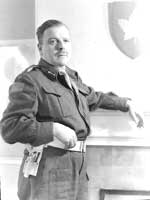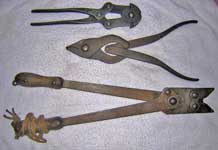Web Equipment Pattern 1908 - Associated Equipment
Wire Cutters & Frogs (soon to be re-located to its proper place in Non-Patterned Equipment)
Cutter, wire, Mark V
Cutter, wire, small, Mark V
This Wire cutter was introduced by L. of C. 16267, approved on 22nd January 1912. It was part of an ongoing succession of Cutters, which were necessitated by ever thicker gauges of wire which might be deployed against the British Army. It was designed to cut No. 4 S.W.G. (Standard Wire Gauge) of mild steel or hard-drawn iron wire, No. 4 gauge being 0.232 inches in diameter. The “nose” of the Cutter provided three sets of jaws, aligned with one pointing forward and the others disposed laterally. A projecting hook, in front of the side jaws, provided a quick location on the wire to be cut, which would then be drawn into the side-jobs. In operation, they worked on the compound lever system, which increased the mechanical advantage over types which had one pivot point, like pliers. With their introduction, manufacture of the Mark IV Cutter ceased. When, in 1913, L. of C. 16824 introduced the Cutter, wire, large. (Mark I.), the Mark V was further qualified as “…small…”, together with the obsolescent Marks I, III and IV being similarly amended.
Frog, brown, wire cutter, Mark III
Strap, with buckle (No photograph available)
Strap with stud (No photograph available)


![]()
 The Mark V Wire cutter required a larger Frog and this was introduced by L. of C. 16264, approved 9th February 1912. The belt loop was also made larger, in order that the Frog could be fitted to Patt. ’08 W.E. Waist belts. In addition, the rectangular brass loop was moved to the centre of the rear face. Beyond the comment in the L. of C., that the studded strap was 3.5 inches longer, no detail of their use was provided. This is to be found in L. of C. 13557, which introduced the Mark II Frog. On this Mark, the buckled strap passed through the belt loop and was secured to the front saddle arch, on its nearside, i.e. the left. The studded strap was used horizontally, attached around the “V” attachment of the saddle girth. The Mark II’s brass loop is believed to have been on its right-hand edge, for ease of connection to the girth’s “V” strap. The re-located brass loop is taken to indicate that direct attachment to the front of the Saddle Wallets was also facilitated. The example shown here is from the Collection of Chris Cutting. Photographs © Chris Cutting 2009.
The Mark V Wire cutter required a larger Frog and this was introduced by L. of C. 16264, approved 9th February 1912. The belt loop was also made larger, in order that the Frog could be fitted to Patt. ’08 W.E. Waist belts. In addition, the rectangular brass loop was moved to the centre of the rear face. Beyond the comment in the L. of C., that the studded strap was 3.5 inches longer, no detail of their use was provided. This is to be found in L. of C. 13557, which introduced the Mark II Frog. On this Mark, the buckled strap passed through the belt loop and was secured to the front saddle arch, on its nearside, i.e. the left. The studded strap was used horizontally, attached around the “V” attachment of the saddle girth. The Mark II’s brass loop is believed to have been on its right-hand edge, for ease of connection to the girth’s “V” strap. The re-located brass loop is taken to indicate that direct attachment to the front of the Saddle Wallets was also facilitated. The example shown here is from the Collection of Chris Cutting. Photographs © Chris Cutting 2009.
Frog, cutter, wire, folding. (Mark I.)


 Introduced by L. of C. § 20641 (acceptance date 26th April 1917), the Frog, cutter, wire, folding. (Mark I.) was designed to carry the Cutters, wire, folding. (Mark I.) discussed below. The same L. of C. made the leather Mark III Frog (above obsolete). This type of Frog was in service for many years and may in fact still be in use. The writer (John Thorne) saw the British forces carrying identical Wire cutters and Frogs during the First Gulf War in Saudi Arabia in 1990-91, and has been noted with production dates as late as 1990. The purpose of the small loop on the back was for attachment of a lanyard to the Cutter. It also served for strapping the Frog to saddlery, probably via the straps around the Saddle Wallets across the pommel. In early Frogs, such as this M.E. Co. made 1917 dated example, the "loop" is a brass rectangle. In later ones, it became a blackened steel loop.
Introduced by L. of C. § 20641 (acceptance date 26th April 1917), the Frog, cutter, wire, folding. (Mark I.) was designed to carry the Cutters, wire, folding. (Mark I.) discussed below. The same L. of C. made the leather Mark III Frog (above obsolete). This type of Frog was in service for many years and may in fact still be in use. The writer (John Thorne) saw the British forces carrying identical Wire cutters and Frogs during the First Gulf War in Saudi Arabia in 1990-91, and has been noted with production dates as late as 1990. The purpose of the small loop on the back was for attachment of a lanyard to the Cutter. It also served for strapping the Frog to saddlery, probably via the straps around the Saddle Wallets across the pommel. In early Frogs, such as this M.E. Co. made 1917 dated example, the "loop" is a brass rectangle. In later ones, it became a blackened steel loop.
 Here is another, unofficial, use for the Frog, cutter, wire, folding. (Mark I.). This is Canadian Major General Rod Keller, who commanded the 3rd Canadian Infantry Division at Juno Breach on D-Day. He is carrying his M1911 pistol in a Folding wire cutter frog. Interestingly, I have seen another picture where a Canadian officer used this Frog for a pistol holster, so it may have been, if not common, at least a known practice.
Here is another, unofficial, use for the Frog, cutter, wire, folding. (Mark I.). This is Canadian Major General Rod Keller, who commanded the 3rd Canadian Infantry Division at Juno Breach on D-Day. He is carrying his M1911 pistol in a Folding wire cutter frog. Interestingly, I have seen another picture where a Canadian officer used this Frog for a pistol holster, so it may have been, if not common, at least a known practice.
Cutters, wire, folding. (Mark I.)

 This style of Folding wire cutter was introduced by L. of C. § 20646 (acceptance date 1st December 1916). As mentioned in the previous section, these Folding wire cutters were in service from their introduction (1916 dated examples have been noted) until at least 1991. This pair is maker marked "CARR WILD & Co. Ltd." and dated 1917.
This style of Folding wire cutter was introduced by L. of C. § 20646 (acceptance date 1st December 1916). As mentioned in the previous section, these Folding wire cutters were in service from their introduction (1916 dated examples have been noted) until at least 1991. This pair is maker marked "CARR WILD & Co. Ltd." and dated 1917.
 There were many types of Wire cutters used by the British forces during the Great War. Here are three typical examples. In this picture, the top one is dated 1914. The other two are both dated 1917.
There were many types of Wire cutters used by the British forces during the Great War. Here are three typical examples. In this picture, the top one is dated 1914. The other two are both dated 1917.